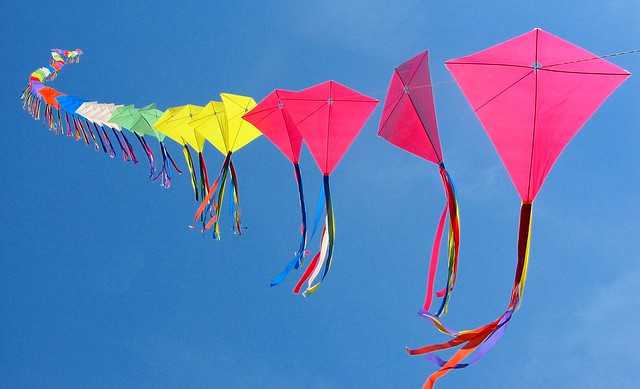
Todd Irvine, Spacing’s former Green Space columnist, is now writing for Eye Weekly. This is a cross-post from Eye about Windfest. Spacing is a proud sponsor of this event.
![]()
This Saturday, the skies above Woodbine Park will be streaked with colour as they are filled with hundreds of kites, from delicate handmade paper ones to elaborate acrobatic trains on single lines. It’s the maiden flight of the Windfest kite festival.
The kites will be the stars of the day, with onlookers and media eagerly photographing and videotaping their playful dances, but it is the wind blowing in off lake Ontario that will make it all happen. The flight of the kites illustrates the wind power that is coursing above us ready to be harnessed as energy.
Local super-activist Dave Meslin, one of Windfest’s organizers, sees the day as an opportunity to combine politics and fun. “Energy is a huge issue, and everyone agrees that wind energy is part of the solution. A good way to think about it is by flying kites and bringing together those who love the wind.”
Event participants include key wind-power players like the Canadian Wind Energy Association, the Ontario Sustainable Energy Association and the Toronto Renewable Energy Co-operative, on hand to provide information and answer questions about the benefits of green energy.
Kites and wind energy in Toronto share something else: resistance. Just a few weeks ago, Parks Department staff and local Toronto Councillor Chin Lee placed a ban on kites in Milliken Park. They cited concerns about sharp kite lines being left on the ground and wound in trees, injuring birds and, in one case, cutting a child’s leg. The ban culminated with the erecting of a “No Kite Flying” sign complete with a red circle and slash over a kite. With that image, the sign could have just as easily read: “No Fun Allowed.”
The controversial lines were left behind by people kite fighting, a common leisure activity in Pakistan, Afghanistan and India in which participants each have a kite in the air and attempt to get under their opponent’s kite and cut their string. The person with the last kite in the air wins. Traditionally, and still in many instances, kite fighting is done with ordinary cotton string, but there are now those who elect to use stronger lines that are metallic or coated in chemicals and fine glass. When those lines are left on the ground, they can cause serious injury.
Meslin argues that the city should enforce the existing Toronto bylaw that mandates picking up kite debris. Representatives from the kiting community have since met with parks staff and Councillor Lee. The meeting ended with Lee going out to fly a kite. Parks staff is working on a resolution and no new bans are expected.
Wind turbines are also receiving a bumpy ride. Toronto Hydro has a proposal to study constructing wind turbines four kilometres off the Scarborough bluffs. The plan is a join venture between Toronto Hydro and a co-operative of local citizens, similar to the arrangement with the wind turbine on the Exhibition Place grounds. Having turbines in the distance gracefully, passively harnessing the wind sounds like a wonderful dream, and it is already common in parts of Europe. Yet the plan for the turbines in Lake Ontario has been aggressively resisted by some residents, who argue that the turbines will be a blight on the horizon and kill migratory birds. Perhaps fearing the backlash, the province has now changed the regulation on turbines to require that they be at least five kilometres from shore, putting the future of the Scarborough project into question.
Kris Stevens, the Executive Director of the Ontario Sustainable Energy Association (OSEA), whose organization supports groups working on community energy projects, is disappointed by the resistance to the Scarborough project, especially since, at this point, the intention is merely to install a device offshore to measure the wind capacity to see if the location is even suitable. Stevens stresses that, before any green energy project can go ahead in the Ontario, it must first go through a rigorous environmental assessment, which includes bird studies.
As with the kites, when questions arise, it seems that the initial and loudest response is for a complete ban, even before the facts have been gathered. Rather than indulging that outcry, we need an open, healthy debate about our energy demands and how we will meet our needs.



3 comments
What about simply banning plastic kite string?
The strings modified with glass, chemicals and metal are banned by the exiting City By-law. Sorry, this information was cut from the original article when it was edited for length.
Give the NIMBYs options. Let them decide if they prefer wind turbines 4 KMs out or would rather have a gas/small nuclear/or aging coal plant nearby.
The spinning turbines will look much more appealing then.
Our energy future depends on many things including conservation first and foremost (ban TVs bigger than 26″ and lock thermostats at a comfy 21 year-round) and local generation as we have neither the capital to build & maintain long distance transmission and we’ve long ignored the need to store energy rather than simply generate and sell to market.